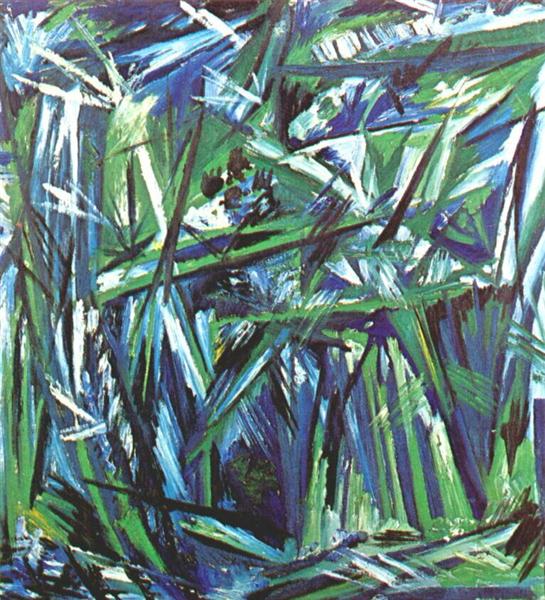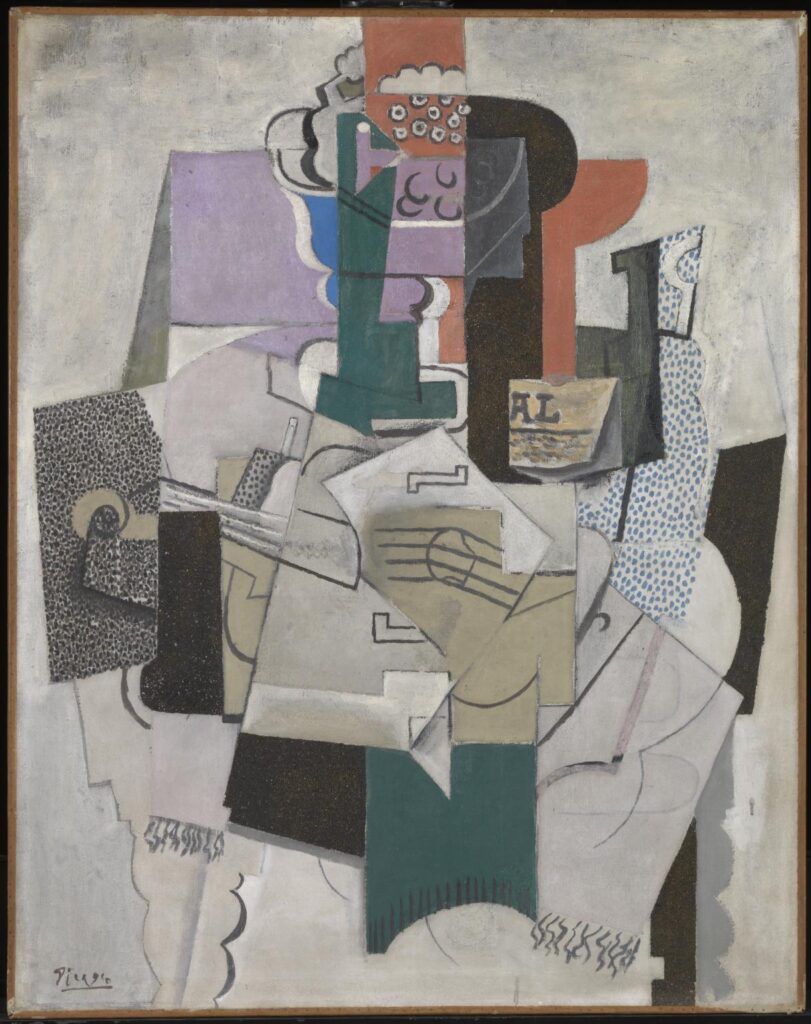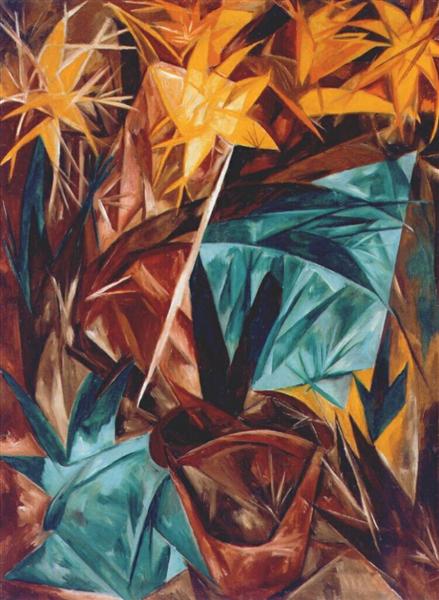Rayonism is an art movement that was created by Russian artists Mikhail Larionov and Natalia Goncharova in 1912. Directly influenced by Cubism, Rayonism is concerned with capturing the effects of light on objects, landscapes, and people. Rayonism is considered an early development in abstract art.
Cubism originated in France and was active between 1907 and 1914. Cubist artwork features a fragmented composition representing the subject from all angles through overlapping geometric planes. Artists Pablo Picasso and Georges Braque experimented with form and composition to steer Cubism through its phases: Proto-Cubism, Analytical Cubism, and Synthetic Cubism.
Rayonism and Cubism have many similarities and differences. The three main similarities between Rayonism and Cubism are dynamic composition, subject matter, and loose brushwork. The three main differences between Rayonism and Cubism are abstraction, influences, and color palette.
Rayonism and Cubism Similarities
Rayonism and Cubism have many similarities, mainly since Cubism influenced Rayonism in many ways. Three main similarities between Rayonism and Cubism are dynamic composition, subject matter, and loose brushwork.
Rayonism vs. Cubism: Dynamic Composition
Rayonist artists often used dynamically intersecting lines to represent rays of light in motion. Rayonist artists could allude to the immaterial world beyond the human eye by recording how rays of light reflected off objects, people, and landscapes in the material world. Venturing to record rays of light led to highly dynamic compositions in Rayonist paintings, as seen in Natalia Goncharova’s Green Forest, below:

Cubist artists achieved dynamic compositions by painting their subjects as a compilation of overlapping planes, forms, and angles. This technique also made subject matter appear to be in motion, rather than a static form confined to a canvas.
Rayonism vs. Cubism: Subject Matter
Cubism and Rayonism explore similar subjects, including still lifes, landscapes, and portraits. However, Rayonist artists focused on the metaphysical layer surrounding each subject and how light interacted with the subject. Rayonist artists merely alluded to objects, people, and spaces by focusing on light as subject matter. The true focus of a Rayonist painting became how objects disintegrated into light.
Cubism was more concerned with how subjects could be reimagined from all angles in a single picture plane. Pablo Picasso’s Bowl of Fruit, Violin, and Bottle, pictured below, demonstrates how a still life is portrayed from multiple angles at once:

Rayonism vs. Cubism: Loose Brushwork
Rayonist and Cubist paintings typically feature loose, constructive, and fragmented brushstrokes. Rayonism and Cubism distanced themselves from the conventions of literal representation and embraced a more organic painting style.
Cubists reassembled their subjects using short, sketch-like brushstrokes to build up color and value in opaque layers. For Rayonists, layered and loose brushstrokes also suggest the movement of light and energy, especially when paired with bright colors. Cubist and Rayonist artists could achieve more complex compositions visually and conceptually by painting with loose brushstrokes.
Rayonism and Cubism Differences
Despite Cubism’s influence on Rayonism, Rayonism set itself apart from Cubism in many ways. The three main differences between Rayonism and Cubism are abstraction, influences, and color palette.
Rayonism vs. Cubism: Abstraction
Initially, Rayonism was inspired by the geometric forms and facets central to Cubism. However, in pursuit of representing light rays and the movement of energy, Rayonist artwork became increasingly abstract. Abstraction represented a form of artistic “purity,” and Rayonist artists prioritized color, form, and composition over illusionism.
Cubism also rejected illusionism but did not achieve abstraction with intention. Cubist paintings appear to be abstracted versions of their subjects simply because of the process of dissecting and reassembling that Cubist artists used to achieve their version of pure artistic representation.
Rayonism vs. Cubism: Influences
Rayonism celebrated aspects of modern life such as popular culture, growing industry, and technological advancements such as X-rays, trains, and airplanes. Rayonists also connected with the idea of the fourth dimension, a theory proposed by Russian mathematician Peter D Ouspensky in 1909. This theory supported the Rayonist intention of representing the immaterial.
Cubism was influenced by African and Cycladic art, which influenced the aesthetic qualities of the Cubist movement, such as geometric features and flattened composition. Cubism was intended as an exploration of technique, aesthetics, shape, and form rather than an exploration of morality, spirituality, or psychology.
Rayonism vs. Cubism: Color
For Rayonist artists, color played a vital role in expressing spirituality, an environment, a state of mind, or an aspect of morality. Light rays and vivid colors are often combined in Rayonist paintings to convey fleeting beams of light through overlapping layers of paint. Using vivid colors also meant that Rayonist artists could convey a greater sense of emotion. In Natalia Goncharova’s Rayonist Lillies, pictured below, color is used to emphasize the movement of light between the lillies:

Cubist paintings, particularly those of the Analytic Cubism phase, feature a monochromatic color palette with mainly dark, earthy tones. Cubist artists often used a monochromatic scale to keep the viewer focused on their subject matter’s complex form rather than a profound feeling.
How did Cubism Influence Rayonism?
Rayonist artists were interested in the shapes created by Cubist painters, particularly their fragmented and geometric qualities. These overlapping geometric facets appeared in many early Rayonist paintings. Rayonism’s overall treatment of form and space reflects the characteristics of Cubism, Russian Futurism, German Expressionism, and Orphism.
What are Other Art Movements Similar to Rayonism and Cubism?
After 1914, Rayonism founders Mikhail Larionov and Natalia Goncharova went on to create artwork with Der Blaue Reiter under the umbrella of the Expressionism art movement. Rayonism, Cubism, and Expressionism share the element of abstraction, though with varying levels of intention. Rayonism and Expressionism both used vivid colors and varying levels of abstraction to communicate views on morality and reality.
Rayonism also influenced later developments in abstract art, including the Russian Constructivists Vladimir Tatlin, El Lissitsky, and Alexander Rodchenko.
However, Impressionism is most closely related to Rayonism. Impressionist painters’ main concern was to capture light’s effects on landscapes, similar to Rayonist artists’ concern with capturing the movement of light rays reflected off of objects, landscapes, and people.
